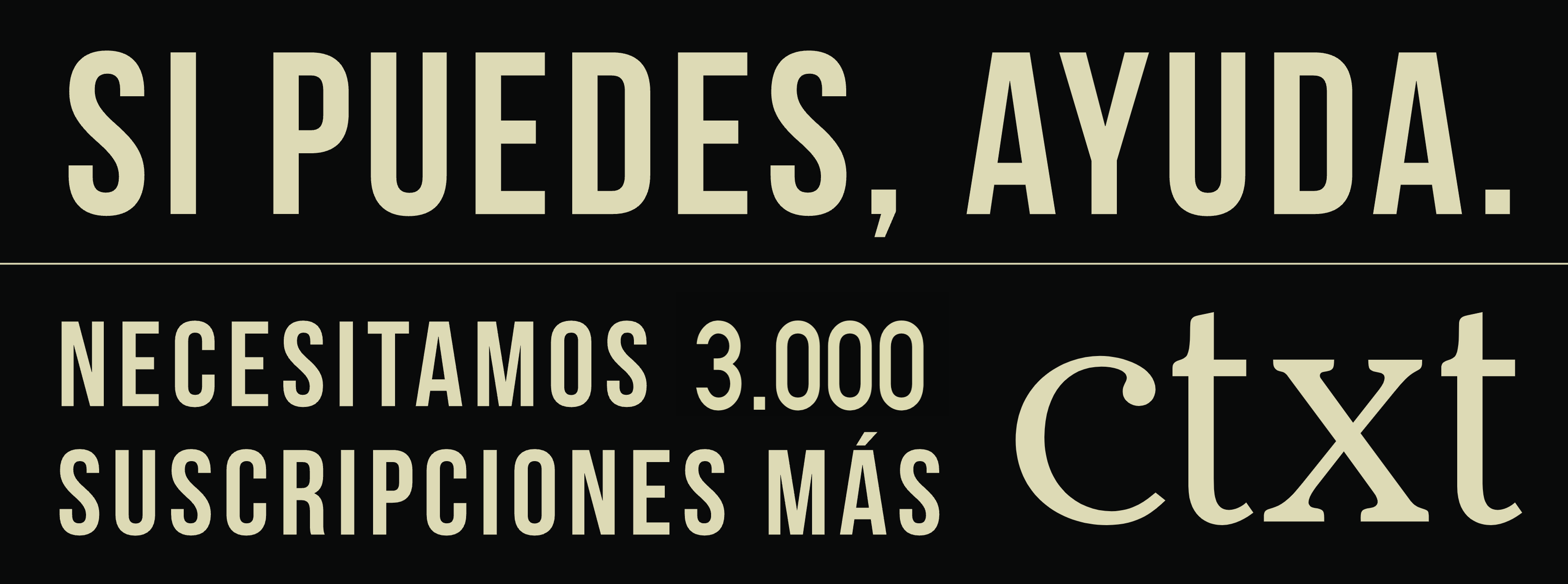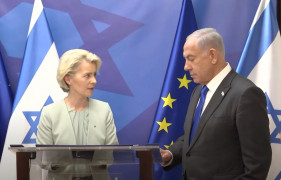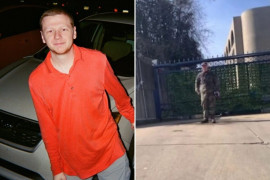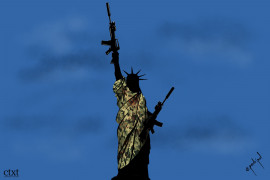REPRESSION
Police and pro-Palestine protests at Columbia University
The prestigious New York university decrees virtual classes after six days of encampment in solidarity with Gaza. The police entered and arrested more than a hundred students, as they did in 1968 to stop the mobilization against the Vietnam War
Claudia Gohn Anna Oakes Columbia University, New York , 23/04/2024
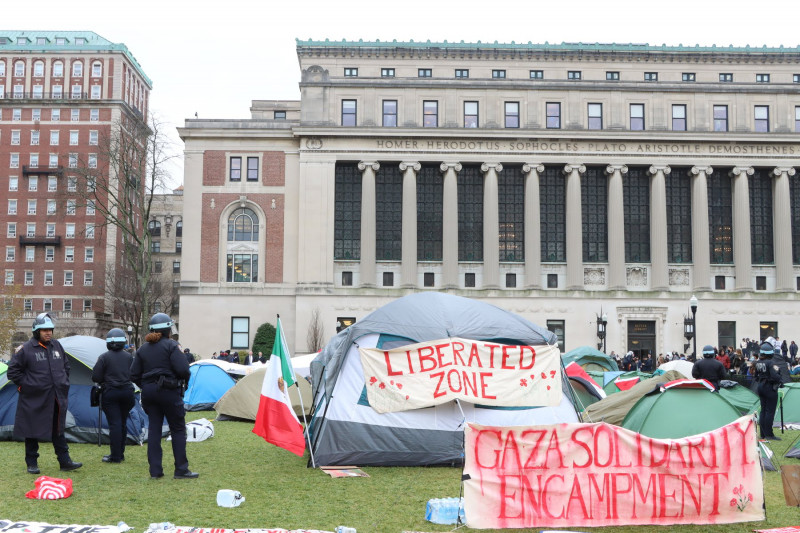
Police agents in the proPalestine encampment in Columbia University, New York.
En CTXT podemos mantener nuestra radical independencia gracias a que las suscripciones suponen el 70% de los ingresos. No aceptamos “noticias” patrocinadas y apenas tenemos publicidad. Si puedes apoyarnos desde 3 euros mensuales, suscribete aquí
One of the most distinguished universities of the United States is in turmoil. Since Wednesday, hundreds of students have occupied the central lawn of Columbia University in New York City, along with a battalion's worth of sleeping bags, blankets, granola bars, and roast chicken.
This weekend in April should be one of the busiest periods for the university. In a typical year, the campus is flooded with nostalgic, deep-pocketed alumni and nervous prospective students, part of an ecosystem of fundraising that is central to the functioning of this private institution. Instead, the campus is on lockdown. The iron gates that surround Columbia are slammed shut –in some cases with hastily-applied bike locks – and campus security scrutinizes the identity cards of every student, or counterfeit student, who attempts to enter.
Student protests against Columbia’s investments in Israel have been a near-weekly occurrence on campus since October 8th. Tensions between pro-Palestine and pro-Israel groups have escalated in the months since. Vans displaying the private information of pro-Palestine students and accusing them of antisemitism regularly park outside the campus gates. Students report being followed home by police. University leadership has penalized public displays of protest, including through student suspensions and the cancellation of faculty contracts. In conversations over the past several days, students, professors and alumni have spoken of a profound shift in their understanding of their place within the university.
It’s an echo of the protests fifty years ago, when Columbia was the scene of tensions between police, faculty, and students over the university’s complicity and profiting off the Vietnam War. Today, once again, Columbia is at the center of an American reckoning over its involvement in an overseas catastrophe.
Most students, fearing university retaliation and “doxing,” wear face coverings and refuse to share their names with reporters
In front of the university library, hundreds of students have built an improvised encampment that has quickly evolved into an network of warm food, homework, piles of readily donated blankets, dance performances, movie nights, and teach-ins on a century of Palestinian and Israeli history. Visiting speakers – Cornel West, Norman Finkelstein, and local politicians– have made appearances. At night, the students curl up in sleeping bags.
Students dance at the encampment against US complicity in the genocide in Gaza / C. G. and A. O.
But underneath the festive atmosphere lies a baseline of tension. Most students, fearing university retaliation and “doxing,” wear face coverings and refuse to share their names with reporters. From outside the university gates, sounds of police sirens and chants from non-university activists drift over the encampment. A group of counter-protestors waving enormous Israeli flags approaches every few hours, broadcasting Matisyahu and John Lennon over the encampment.
Tensions came to a head on Thursday afternoon. The night before, in anticipation of University President Minouche Shafik’s testimony before Congress, a group of student activists had snuck onto campus and pitched dozens of tents outside of the university library. They announced the establishment of the “Gaza Solidarity Encampment” and “Liberated Zone,” and demanded that the university divest from companies tied to Israel.
University leadership was not having it. On Thursday, lines of police officers in riot gear, wielding batons and bulletproof vests, descended on the encampment at the invitation of Shafik. Within an hour, 108 student protesters –and two independent legal observers– had been marched and carried off campus in handcuffs on charges of trespassing, to the chagrin and tears of the hundreds of classmates watching.
During the arrests, all members of the university community had received an email from Shafik, coordinated to the time of the police mobilization, that defended her authorization of the police action as a necessary step to protect students from “a harassing and intimidating environment.”
In a press conference soon after the arrests, Police Chief John Chell emphasized precisely the opposite: “The students that were arrested were peaceful, offered no resistance whatsoever and were saying what they wanted to say in a peaceful manner.”
While the students were released later that night from police custody, they have all been suspended by the university.
Many students and faculty alike see echoes of the current university response in the last time police were authorized to enter the campus. In 1968, in the middle of the Vietnam War, students at Columbia occupied buildings across campus to demand the university cut ties to the Department of Defense and halt the construction of a private gym in the historically Black neighborhood of Harlem. The 1968 protests culminated in the violent removal and arrest of hundreds of students.
In the aftermath of those protests, a university senate was established to bring student and faculty influence into the governance of the university. But faculty speak of a steady erosion of their influence in recent years, as the self-governance committees have been gradually pushed aside in critical university decisions.
Susan Bernofsky, professor of writing at Columbia, has taught at the university for over 10 years and is a member of the senate. She said she noticed immediate changes when the current university administration came into office, in summer 2023—especially in response to the protests that began after October 7.
“What has been happening this winter seems to me unprecedented. I've noticed more policing on campus, certainly far more NYPD officers than I've ever before in my life seen on campus at any time.”
Bernofsky, who held a sign that said “Unsuspend my students!,” said she felt a responsibility for all students’ welfare on campus. “It was a very shocking and difficult sight to see NYPD officers dragging students off the green of their own university,” she said. “I feel that every student on this campus is my student. And so I take this very personally to see any student being arrested needlessly.”
Susan Bernofsky, professor of writing at Columbia, with a poster calling for the reinstatement of the reprisaled students / C. G. and A. O.
Columbia’s current crackdown on students stands in stark contrast to the narrative it tells about its own history—including the 1968 protests.
“The sad part is that 50 years from now they're going to profit off of it,” a first-year student, who asked to remain anonymous for fear of retaliation, said. “I'm in a class right now where they're essentially teaching about Columbia's history and they're like, ‘we're so proud of our students for the 1968 protest.’”
“I think it's disheartening, and it just shows that with huge, prestigious and Old Guard universities like this, there's always going to be this establishment that fights against whatever new ideas we bring in.”
Many of the pro-Palestinian student protestors arrested on Thursday have been suspended and banned from university-owned housing. Students at the Columbia-affiliated Barnard College were only allowed 15 minutes in their dorms to pack up their belongings. Other students were suspended when they went to pick up their belongings that had been confiscated from the broken-up encampment.
Gregory Khalil, adjunct assistant professor at the Columbia Graduate School of Journalism, criticized the university’s outsize response to student activism. “This administration has made a clear decision that these perspectives, these students, these lives don't matter,” he said. “They have chosen power and privilege over education and responsibility, and in fact, over the very safety that they say they're trying to protect. This is unraveling now because of their decisions, not the righteous protesting of the students.”
The university has chosen power and privilege over education and responsibility
Within an hour of the Thursday arrests, and despite the risk of university and police retaliation, students quickly moved to establish a new encampment in sight of the old one, which had been torn down by university staff.
That is where the encampment now stands, four days later. One organizer, who had been arrested on Thursday and released later that night, was back to protesting on Friday. They also asked to remain anonymous. “Yesterday, it was incredibly intense and shocking to see the university send cops onto campus and arrest peaceful students,” they said.
While police activity on campus has subsided, the opposite has been true outside Columbia’s gates, where protestors from around the city have gathered in support of the students inside. On several occasions, police officers have arrested non-university-affiliated protesters.
Students inside the gates say they have no intention of leaving. On Sunday morning, tents popped up like mushrooms on the lawn of the new encampment. Some have signs on them; one reads “Power to the People.” Palestinian flags, many of them with the names of Palestinians who have been killed, blanket the empty spaces on the lawn, with more signs scattered around.
They express deep frustrations with university leadership and the omnipresence of public safety officers. But there is also a collective sense of hope running through campus. “I think it's really beautiful to see students coming together like this and seeing them occupy space, despite the university doing its best to intimidate everybody,” the anonymous student organizer said. “It's really amazing.”
Many professors, like Khalil, agree. “This isn't to shame the university,” he said. “It's to remind us of who we are and what our role is and what our potential is. And these students are the future. These students are what give me hope that perhaps these horrors that we're witnessing today, which were totally predicted and avoidable, do not have to be repeated. If there are any criminals here, it's not these students. It's the university and the administration who's weaponized anti-semitism, who has peddled in anti Palestinian bigotry, and who's abdicated their core educational responsibilities.”
One of the most distinguished universities of the United States is in turmoil. Since Wednesday, hundreds of students have occupied the central lawn of Columbia University in New York City, along with a battalion's worth of sleeping bags, blankets, granola bars, and roast chicken.
This weekend in April...
Autor >
Claudia Gohn
Autor >
Anna Oakes
Suscríbete a CTXT
Orgullosas
de llegar tarde
a las últimas noticias
Gracias a tu suscripción podemos ejercer un periodismo público y en libertad.
¿Quieres suscribirte a CTXT por solo 6 euros al mes? Pulsa aquí
